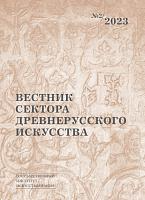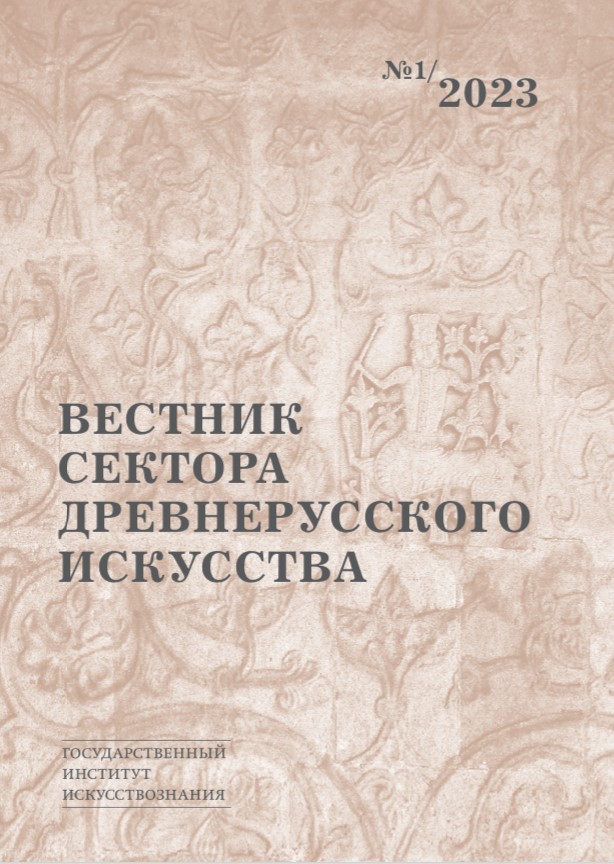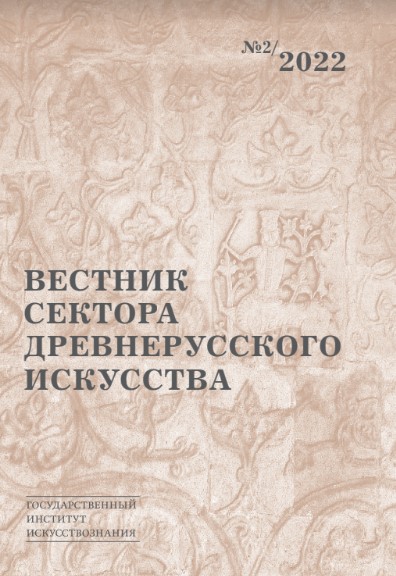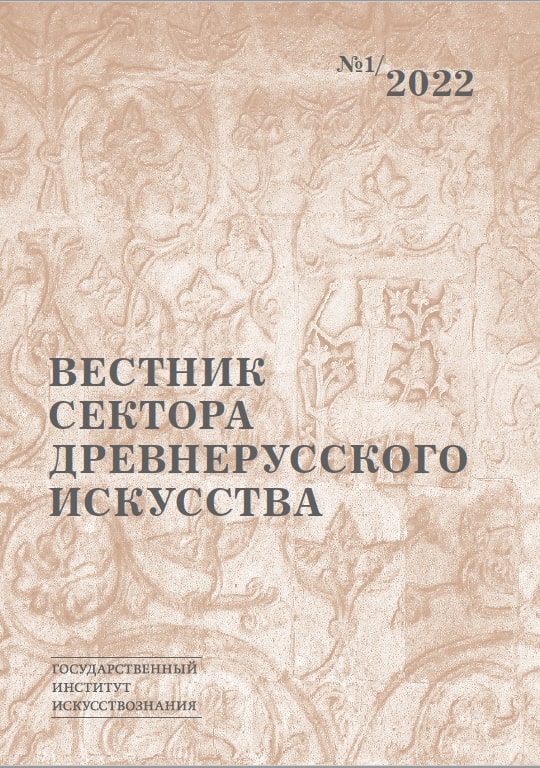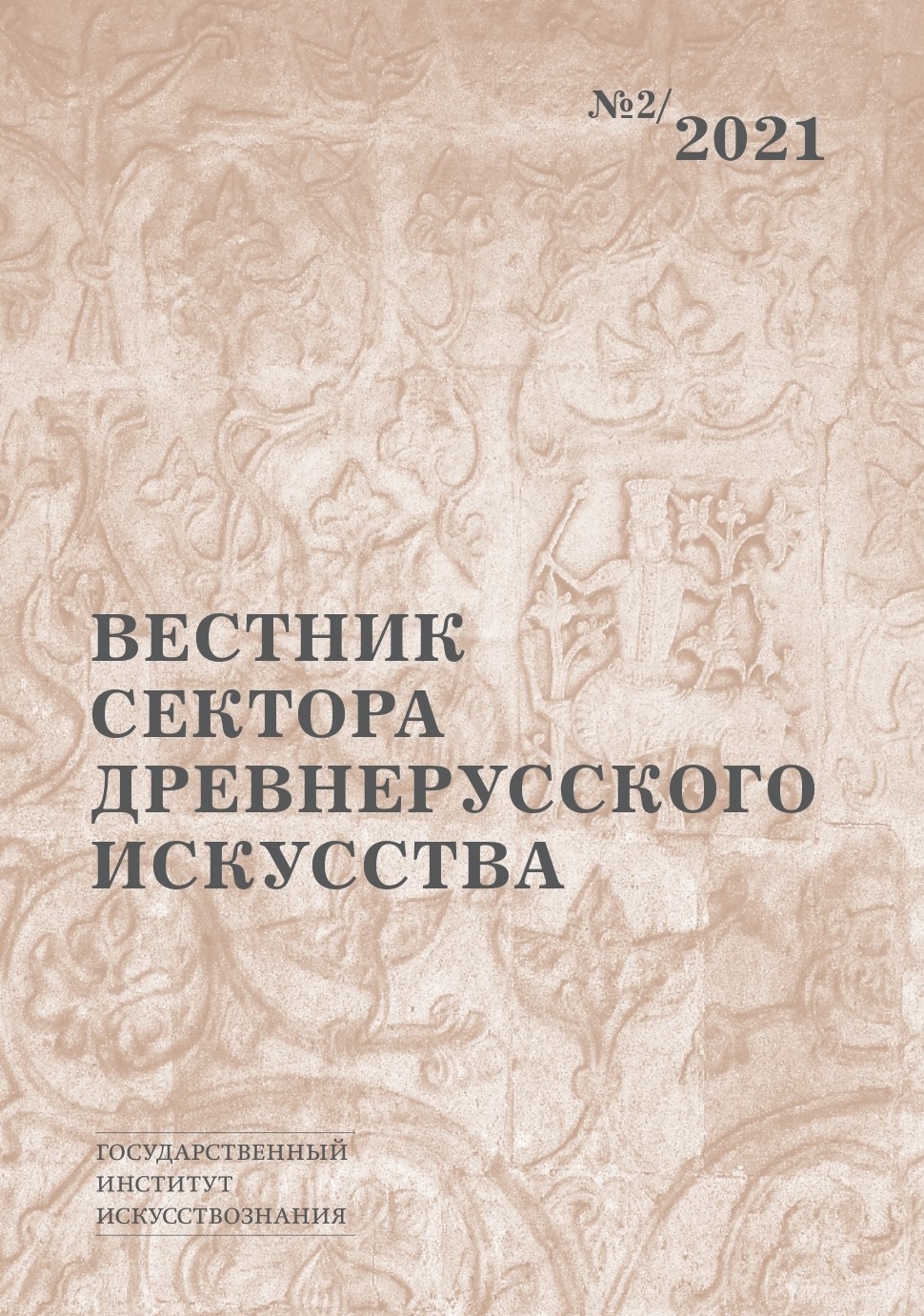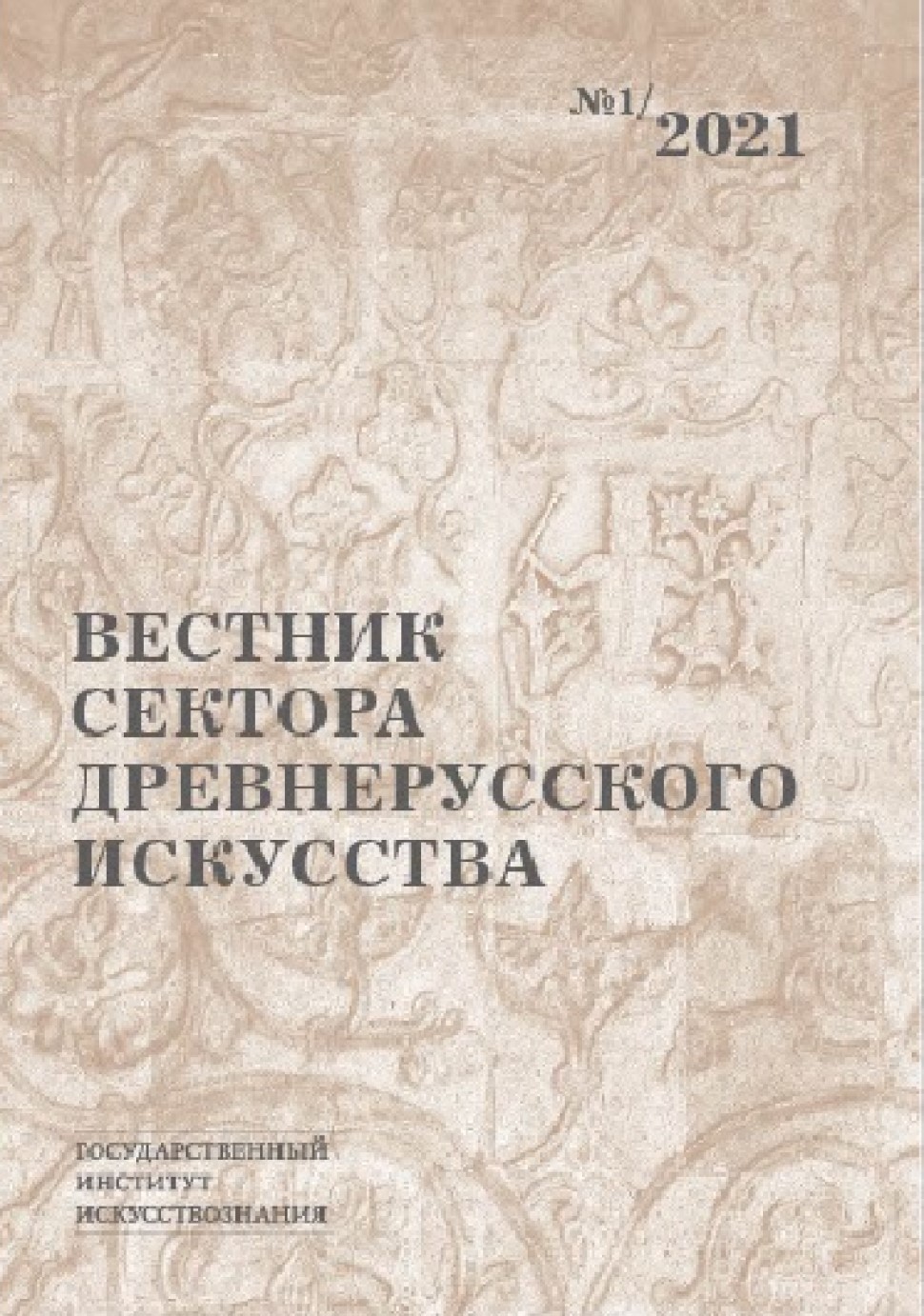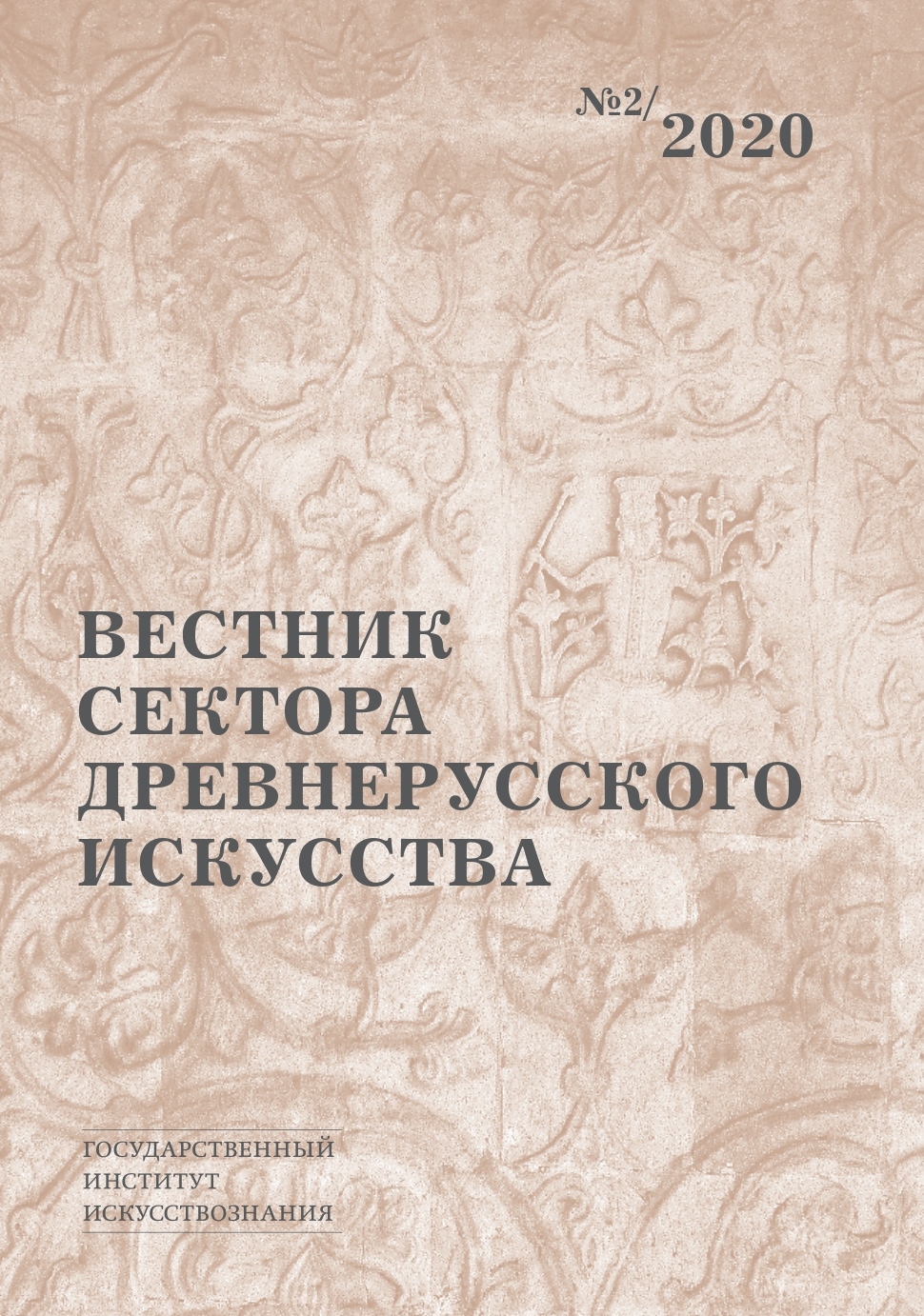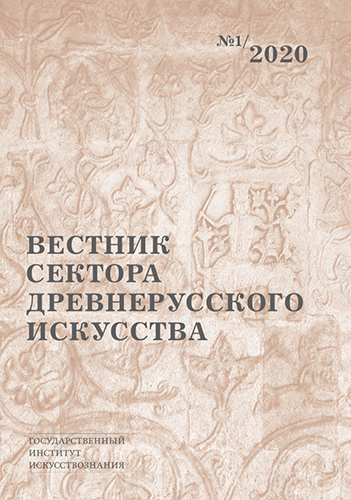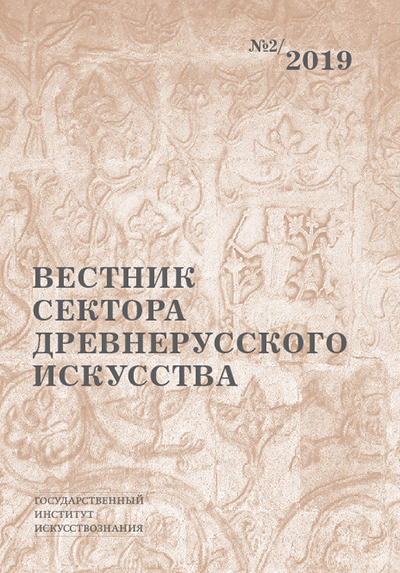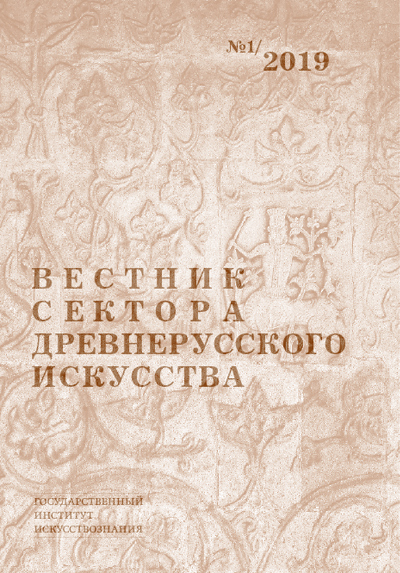2022 ¹ 1
Contents
Articles
Valeriy Igoshev. Research on Typology and Craft Techniques of Ancient Russian Stone Shrines of the 11th–15th Centuries, Decorated with Gilded Silver
Abstract
Abstract The article is dedicated to ancient Russian stone shrines of the 11th–15th centuries decorated with gilded silver. Based on written sources, as well as similar objects, the article studies the typology, manufacturing techniques and methods of attaching silver oklads to shrines and tombstones.
Keywords Reliquary, sarcophagus, shrine, ancient Russian silversmithing, forging, toreutics.
Ekaterina Chamorovskaia. Textile Curtains in Russian Medieval Manuscripts of 12th–16th Centuries: Codicological, Technical and Technological Aspects
Abstract
Textile curtains used in illuminated manuscripts are pieces of thin silk fabric with or without a paper or parchment frame. As a rule, the curtain is located between the miniature and the text. Presumably its function is to prevent the ink and the paint layer from imprinting on each other. Curtains can be divided into two types according to the mounting method. Curtains of the first type are pieces of fabric sewn into the spine of the codex, while curtains of the second type are glued to the spine fold or to the free field of the sheet next to the miniature (headpiece). It is often difficult to find out when a curtain of the second type was added to a manuscript. Textile curtains are found in Byzantine, Western European and Slavic manuscripts from different periods. The oldest Russian manuscript with textile curtains is the Mstislav Gospel. However, analysis of the structure of this codex shows that the curtains were not originally part of it, but were the result of repairs carried out in the 16th century. Starting from the middle of the 15th century textile curtains almost become an integral part of Russian illuminated manuscripts. In the 16th century, illuminated manuscripts with silk curtains are so numerous that they can hardly be enumerated. During this period, curtains of a new type appear — small “windows” in a sheet of paper covering the headpieces. In a number of cases, the curtains finally lose their protective function and become a purely decorative element of the codex.
Keywords
Silk curtains in manuscripts, textiles in manuscripts, Russian medieval illuminated manuscripts, Russian medieval art, codicology, medieval repairs in manuscripts.
Marina Serebriakova. Was it Prokhor of Rostov who built the Assumption cathedral of Kirillo-Belozerskiy monastery?
Abstract
The author reconsiders the date and attribution of the Assumption cathedral of Kirillov-Belozersky monastery, offered by Nikolskiy in his volume about Kirillov-Belozerskiy monastery, published in 1897. According to Nikolskiy and all the authors following him, the cathedral was built in 1497 under the guidance of certain Prokhor Rostovskiy. The revision of the written sources, including those published since Nikolskiy’s book had been released, shows that the date of building and information about Prokhor refer to different messages. The date has to do with the Assumption cathedral of Kirillov-Belozersky monastery in the late 15th century, while information about Prokhor refers to the building and consecration of the Assumption cathedral in Moscow in 1327. Thereon, the author concludes that the question about the personality of the author of the Assumption cathedral of Kirillov-Belozerskiy monastery is again open.
Keywords
Assumption cathedral of Kirillov-Belozerskiy monastery, Russian Medieval Architecture, Prokhor of Rostov, source studies, chronicles.
Dmitry Davidenko. Assumption Cathedral of the Moscow Kremlin in the Fire of 1547
Abstract
The Assumption Cathedral of the Kremlin was an architectural model due to its status as a temple of the Head of the Russian Church. In the fire of June 21, 1547, it suffered only in the upper parts and in the area of the porch. Sources that seem to us to be more trustworthy do not say that the temple was desecrated by the murder of Prince Yu.V. Glinsky a few days after the fire. The relative lack of damage of the cathedral in the fire, as well as its subsequent restoration have increased the significance of the shrine. The temple began to be perceived to a greater extent as a sacred object, and its importance was emphasized in the narratives of the 16th century about the fire, as well as in the acts of the Stoglav.
Keywords
Moscow Kremlin, Assumption Cathedral, chronicles, fire of 1547, Ivan IV, Metropolitan Makarii, Yu.V. Glinsky, Stoglav.
Liudmila Kovtyreva. About the Precious Decoration of the Icon of the Mother of God Hodegetria (Georgian) from the Intercession Monastery in Suzdal
Abstract
The double-sided icon of the so-called Georgian Mother of God Hodegetria from the Intercession Monastery in Suzdal and its multi-piece precious attire represent a single medieval cultural and historical complex, the scientific development of which was begun in 1910 by V.T. Georgievsky. In 1930, the icon entered the Tretyakov Gallery with its decoration, consisting of metal and fabric parts, decorated with precious stones and pearls. The icon was repeatedly mentioned by experts in studies on ancient Russian painting of the 14th — first half of the 15th centuries, however, the headdress of the venerated icon almost did not attract the attention of art historians. The article acquaints the reader with the intermediate result of the study of the complex framing of the venerated icon, which has evolved over the centuries. Its adequate perception is based on the analysis of the contents of nine archival inventories of monastic property of the 16th–19th centuries, which give an idea on the evolution of the decoration as a whole, the changes in its individual parts and its contributors and executors. The descriptions make it possible to trace the changes in the location of the icon in the space of the temple. The totality of the given data on archival documents makes it possible to clarify the attribution of the little-studied image and its decoration, including the problem of its origin and dating.
Keywords
Ancient Russian painting, Pokrovsky monastery in Suzdal, miraculous icon, precious decoration, inventories of monastic property of the 16th–19th centuries.
Iulia Ustinova. “The Visitation of Blessed Virgin Mary” in the Illuminated Manuscript from Ñhudov Ìonastery of the 1560s: To the Problem of Interpreting the Author’s Concept of “Word on the Conception of St. John the Baptist”
Abstract
The illuminated “Word on the Conception of St. John the Baptist” (1560–1570s) from Chudov monastery (Russian State Library. F. 98, collection of Å.Å. Egorov, no. 1844) contains the story of the Visitation of Blessed Virgin Mary, who was pregnant with Jesus, to St. Elizabeth, who was pregnant with John the Baptist (fol. 149v–151). The text is illustrated with two miniatures. A unique feature of these scenes is that the contours of their unborn babies are depicted on the bosoms of Mary and Elizabeth, peeking through their clothes. In Byzantine and ancient Russian art, the image of visible babies on the bosoms of their mothers is not characteristic in this scene. But in the art of Catholic Europe, such an interpretation of the scene has been known since the turn of the 13th–14th centuries, becoming a popular motif in countries of central and eastern Europe. Apparently, it was the Western model that formed the basis for the composition of the studied Russian miniatures. The use of this motif allowed the artists to express the idea of the superiority of John the Baptist over other prophets of the Old Testament, laid down in the program of the manuscript, which is composed as a vita of the patron saint of the first Russian tsar.
Keywords
Old Russian art, 16th century art, Old Russian book miniature, illuminated manuscript of the Chudov Monastery, epoch of Ivan the Terrible, iconography of the Visitation of the Blessed Virgin Mary to St .Elizabeth, iconography of St. John the Baptist, cult of the patron saint.
Irina Shalina. “... This Image was Taken from Wild Fields”: the Novgorod Icon of St. Nicholas the Wonderworker from the Holy Spirit Monastery and the Nikitsky Patrimony of the Sophia House
Abstract
Unlike many Pre-Mongolian icons, whose origin is confirmed or established thanks to written sources, the original purpose of the image of St. Nicholas (middle of the 13th century) from the Holy Spirit Monastery, which is traditionally tied to the decoration of this monastery, remains unknown. Before the removal of the late layer during the restoration of 1925–1928 in the CSRW (Central State Restoration Workshop), there was an inscription on its lower field informing about the creation of the icon in 1500 and its transfer from Dikie Polia (Wild Fields). Such a toponym is found in the documents of the Bishops’ House of Novgorod, where an inventory of the wooden church of Saints Nikita and John the Wonderworkers of Novgorod, erected in the newly acquired patrimony of the Sophia House around 1679, has been preserved. Apparently, the icon of St. Nicholas was also transferred to Dikie Polia among the bishop’s property, and after the sale of the patrimony at the end of the 17th century, it was returned to Novgorod. The origin of the icon can be thus associated with the highest social stratum of the old city.
Keywords
The Great Novgorod, Sophia Archbishop's House, Icon of St.Nicholas, Holy Spirit Monastery in Novgorod, Nikitskoye village, Bogoroditsky district, 17th century, State Russian Museum.
Svetlana Nikolaeva. Archeographic Branch in the Scientific Work of the Sergiev Posad Museum-Reserve. Publishing the Manuscripts of the Monastery Collection
Abstract
The article is devoted to the problem of publishing unique medieval sources from the archive of the Trinity-Sergius Monastery, currently stored in the Sergiev Posad Museum-Reserve. Describing the brief history of the museum’s archeographic work, the article focuses on the commented edition of the text and research of the 1641 Opis’ (Inventory), published in 2020. It is a unique in its extent manuscript of 883 pages, which serves as a source on the history of the art and book collection of the Trinity Monastery, its economy, the composition of the brethren, the number and occupations of the monastic servants and the population of the patrimony, as well as the monasteries assigned to it. The publication was prepared by S.V. Nikolaeva and L.A. Kirichenko; carried out with the support of the Russian Foundation for Basic Research.
Keywords
Publication of sources, Sergiev Posad Museum-Reserve, Opis' (Inventory) of the Trinity Monastery in 1641.
Anna Ivannikova. Iconographic Program of Decorations of the Holy Gates of the Vygoretsky Monastery
Abstract
The article considers a complex of icons from the Holy Gates of the Vygoretsky Monastery, originating from the collection of Vasiliy Druzhinin and stored in the collection of the State Hermitage. Until now, these works have not attracted the special attention of researchers and, as a rule, were considered in the general context of the development of the Old Believer art of Vyg. The location of the icon of the Tikhvin Mother of God on the main gate, facing the Danilov Monastery, testifies to her special patronage of the sacred space of the monastery and reflects important aspects of the veneration of the Tikhvin image of the Mother of God in the Vygoretsky Monastery. Those wishing to enter the monastery were “met” by a threefigure Deesis, the ideological idea of which was reduced to the topics of repentance in the face of death and intercession of the Mother of God at the Last Judgment, which were relevant for Old Believers. Thus, the program of decoration of the Holy Gates is closely connected with the idea of entering the sacred space of the monastery through the “Gate of Salvation”, which personified the symbolic entrance to the Heavenly Jerusalem. The time of the creation of the three icons of Deesis (about 1735) and the image of Our Lady of Tikhvin (about the middle of the 18th century) is associated with the little-studied period of the development of icon painting of Vyg, when the main features of the so-called “Pomorsky style” are laid. In this respect, the complex of early monuments stored in the Hermitage is unique in its significance and allows filling in some gaps in the history of the formation of the local artistic tradition.
Keywords
Vygoretsky Monastery, Holy Gates, over–the–gate Deesis, Our Lady of Tikhvin, Vasily Druzhinin, Vygovsky icon-paintings.
Chronicles
Restoration chronicles
Anna-Maria Ìàêàðîâà, Oksana Polushkina, Vladimir Kalashnikov. Restoration Chronicle. December 2021 — April 2022
Exhibitions
Maria Makhan’ko. Age of Change: Exhibition of Old Russian Icon Painting of the 17th century from the Collection of Konstantin Voronin. Andrei Rublev Central Museum of Ancient Russian Culture and Art. December 22, 2021 — February 21, 2022
Reviews
Georgii Gerov. Margarita Kuyumdzhieva. The Face of God. The Images of the Holy Trinity in Orthodox Art. Sofia: Institute for the Study of Arts, BAS, 2020
Gerold Vzdornov. Church Painting of the Arkhangelsk Province of the Second Half of the 18th — early 20th centuries by Tatiana M. Koltsova
Conferences
Maria Makhan’ko. The Feat of Service. To the 75th Anniversary of Archimandrite Macarius (Veretennikov), Church Historian, Theologian. Conference, November 19, 2021, Trinity-Sergius Lavra
Maria Makhan’ko. International Scientific and Practical Conference The Miraculous Image of the Kazan Mother of God in the Destinies of Russia and World Civilization, July 18–20, 2021
Discussions
Andrei Iaganov, Ekaterina Ruzaeva. Ioannisyan O.M. Once again on the Most Ancient Temples of the Spassky Monastery in Yaroslavl // Δωρεά: On the 90th Anniversary of Engelina Sergeevna Smirnova: a Collection of Articles. Moscow, State Institute of Art Studies, 2022, pp. 152–163
ìîíàñòûðÿ â ßðîñëàâëå // Δωρεά: Ê 90-ëåòèþ Ýíãåëèíû Ñåðãååâíû Ñìèðíîâîé: ñá. ñò. / Îòâ. ðåä. Ì. À. Îðëîâà. Ì.: Ãîñóäàðñòâåííûé èíñòèòóò èñêóññòâîçíàíèÿ, 2022. Ñ. 152–163
In memoriam: Maria Vladimirovna Sarabianova
The article considers a complex of icons from the Holy Gates of the Vygoretsky Monastery, originating from the collection of Vasiliy Druzhinin and stored in the collection of the State Hermitage. Until now, these works have not attracted the special attention of researchers and, as a rule, were considered in the general context of the development of the Old Believer art of Vyg. The location of the icon of the Tikhvin Mother of God on the main gate, facing the Danilov Monastery, testifies to her special patronage of the sacred space of the monastery and reflects important aspects of the veneration of the Tikhvin image of the Mother of God in the Vygoretsky Monastery. Those wishing to enter the monastery were “met” by a three-figure Deesis, the ideological idea of which was reduced to the topics of repentance in the face of death and intercession of the Mother of God at the Last Judgment, which were relevant for Old Believers. Thus, the program of decoration of the Holy Gates is closely connected with the idea of entering the sacred space of the monastery through the “Gate of Salvation”, which personified the symbolic entrance to the Heavenly Jerusalem. The time of the creation of the three icons of Deesis (about 1735) and the image of Our Lady of Tikhvin (about the middle of the 18th century) is associated with the little-studied period of the development of icon painting of Vyg, when the main features of the so-called “Pomorsky style” are laid. In this respect, the complex of early monuments stored in the Hermitage is unique in its significance and allows filling in some gaps in the history of the formation of the local artistic tradition.
Articles
Valeriy Igoshev. Research on Typology and Craft Techniques of Ancient Russian Stone Shrines of the 11th–15th Centuries, Decorated with Gilded Silver
Abstract
Abstract The article is dedicated to ancient Russian stone shrines of the 11th–15th centuries decorated with gilded silver. Based on written sources, as well as similar objects, the article studies the typology, manufacturing techniques and methods of attaching silver oklads to shrines and tombstones.
Keywords Reliquary, sarcophagus, shrine, ancient Russian silversmithing, forging, toreutics.
Ekaterina Chamorovskaia. Textile Curtains in Russian Medieval Manuscripts of 12th–16th Centuries: Codicological, Technical and Technological Aspects
Abstract
Textile curtains used in illuminated manuscripts are pieces of thin silk fabric with or without a paper or parchment frame. As a rule, the curtain is located between the miniature and the text. Presumably its function is to prevent the ink and the paint layer from imprinting on each other. Curtains can be divided into two types according to the mounting method. Curtains of the first type are pieces of fabric sewn into the spine of the codex, while curtains of the second type are glued to the spine fold or to the free field of the sheet next to the miniature (headpiece). It is often difficult to find out when a curtain of the second type was added to a manuscript. Textile curtains are found in Byzantine, Western European and Slavic manuscripts from different periods. The oldest Russian manuscript with textile curtains is the Mstislav Gospel. However, analysis of the structure of this codex shows that the curtains were not originally part of it, but were the result of repairs carried out in the 16th century. Starting from the middle of the 15th century textile curtains almost become an integral part of Russian illuminated manuscripts. In the 16th century, illuminated manuscripts with silk curtains are so numerous that they can hardly be enumerated. During this period, curtains of a new type appear — small “windows” in a sheet of paper covering the headpieces. In a number of cases, the curtains finally lose their protective function and become a purely decorative element of the codex.
Keywords
Silk curtains in manuscripts, textiles in manuscripts, Russian medieval illuminated manuscripts, Russian medieval art, codicology, medieval repairs in manuscripts.
Marina Serebriakova. Was it Prokhor of Rostov who built the Assumption cathedral of Kirillo-Belozerskiy monastery?
Abstract
The author reconsiders the date and attribution of the Assumption cathedral of Kirillov-Belozersky monastery, offered by Nikolskiy in his volume about Kirillov-Belozerskiy monastery, published in 1897. According to Nikolskiy and all the authors following him, the cathedral was built in 1497 under the guidance of certain Prokhor Rostovskiy. The revision of the written sources, including those published since Nikolskiy’s book had been released, shows that the date of building and information about Prokhor refer to different messages. The date has to do with the Assumption cathedral of Kirillov-Belozersky monastery in the late 15th century, while information about Prokhor refers to the building and consecration of the Assumption cathedral in Moscow in 1327. Thereon, the author concludes that the question about the personality of the author of the Assumption cathedral of Kirillov-Belozerskiy monastery is again open.
Keywords
Assumption cathedral of Kirillov-Belozerskiy monastery, Russian Medieval Architecture, Prokhor of Rostov, source studies, chronicles.
Dmitry Davidenko. Assumption Cathedral of the Moscow Kremlin in the Fire of 1547
Abstract
The Assumption Cathedral of the Kremlin was an architectural model due to its status as a temple of the Head of the Russian Church. In the fire of June 21, 1547, it suffered only in the upper parts and in the area of the porch. Sources that seem to us to be more trustworthy do not say that the temple was desecrated by the murder of Prince Yu.V. Glinsky a few days after the fire. The relative lack of damage of the cathedral in the fire, as well as its subsequent restoration have increased the significance of the shrine. The temple began to be perceived to a greater extent as a sacred object, and its importance was emphasized in the narratives of the 16th century about the fire, as well as in the acts of the Stoglav.
Keywords
Moscow Kremlin, Assumption Cathedral, chronicles, fire of 1547, Ivan IV, Metropolitan Makarii, Yu.V. Glinsky, Stoglav.
Liudmila Kovtyreva. About the Precious Decoration of the Icon of the Mother of God Hodegetria (Georgian) from the Intercession Monastery in Suzdal
Abstract
The double-sided icon of the so-called Georgian Mother of God Hodegetria from the Intercession Monastery in Suzdal and its multi-piece precious attire represent a single medieval cultural and historical complex, the scientific development of which was begun in 1910 by V.T. Georgievsky. In 1930, the icon entered the Tretyakov Gallery with its decoration, consisting of metal and fabric parts, decorated with precious stones and pearls. The icon was repeatedly mentioned by experts in studies on ancient Russian painting of the 14th — first half of the 15th centuries, however, the headdress of the venerated icon almost did not attract the attention of art historians. The article acquaints the reader with the intermediate result of the study of the complex framing of the venerated icon, which has evolved over the centuries. Its adequate perception is based on the analysis of the contents of nine archival inventories of monastic property of the 16th–19th centuries, which give an idea on the evolution of the decoration as a whole, the changes in its individual parts and its contributors and executors. The descriptions make it possible to trace the changes in the location of the icon in the space of the temple. The totality of the given data on archival documents makes it possible to clarify the attribution of the little-studied image and its decoration, including the problem of its origin and dating.
Keywords
Ancient Russian painting, Pokrovsky monastery in Suzdal, miraculous icon, precious decoration, inventories of monastic property of the 16th–19th centuries.
Iulia Ustinova. “The Visitation of Blessed Virgin Mary” in the Illuminated Manuscript from Ñhudov Ìonastery of the 1560s: To the Problem of Interpreting the Author’s Concept of “Word on the Conception of St. John the Baptist”
Abstract
The illuminated “Word on the Conception of St. John the Baptist” (1560–1570s) from Chudov monastery (Russian State Library. F. 98, collection of Å.Å. Egorov, no. 1844) contains the story of the Visitation of Blessed Virgin Mary, who was pregnant with Jesus, to St. Elizabeth, who was pregnant with John the Baptist (fol. 149v–151). The text is illustrated with two miniatures. A unique feature of these scenes is that the contours of their unborn babies are depicted on the bosoms of Mary and Elizabeth, peeking through their clothes. In Byzantine and ancient Russian art, the image of visible babies on the bosoms of their mothers is not characteristic in this scene. But in the art of Catholic Europe, such an interpretation of the scene has been known since the turn of the 13th–14th centuries, becoming a popular motif in countries of central and eastern Europe. Apparently, it was the Western model that formed the basis for the composition of the studied Russian miniatures. The use of this motif allowed the artists to express the idea of the superiority of John the Baptist over other prophets of the Old Testament, laid down in the program of the manuscript, which is composed as a vita of the patron saint of the first Russian tsar.
Keywords
Old Russian art, 16th century art, Old Russian book miniature, illuminated manuscript of the Chudov Monastery, epoch of Ivan the Terrible, iconography of the Visitation of the Blessed Virgin Mary to St .Elizabeth, iconography of St. John the Baptist, cult of the patron saint.
Irina Shalina. “... This Image was Taken from Wild Fields”: the Novgorod Icon of St. Nicholas the Wonderworker from the Holy Spirit Monastery and the Nikitsky Patrimony of the Sophia House
Abstract
Unlike many Pre-Mongolian icons, whose origin is confirmed or established thanks to written sources, the original purpose of the image of St. Nicholas (middle of the 13th century) from the Holy Spirit Monastery, which is traditionally tied to the decoration of this monastery, remains unknown. Before the removal of the late layer during the restoration of 1925–1928 in the CSRW (Central State Restoration Workshop), there was an inscription on its lower field informing about the creation of the icon in 1500 and its transfer from Dikie Polia (Wild Fields). Such a toponym is found in the documents of the Bishops’ House of Novgorod, where an inventory of the wooden church of Saints Nikita and John the Wonderworkers of Novgorod, erected in the newly acquired patrimony of the Sophia House around 1679, has been preserved. Apparently, the icon of St. Nicholas was also transferred to Dikie Polia among the bishop’s property, and after the sale of the patrimony at the end of the 17th century, it was returned to Novgorod. The origin of the icon can be thus associated with the highest social stratum of the old city.
Keywords
The Great Novgorod, Sophia Archbishop's House, Icon of St.Nicholas, Holy Spirit Monastery in Novgorod, Nikitskoye village, Bogoroditsky district, 17th century, State Russian Museum.
Svetlana Nikolaeva. Archeographic Branch in the Scientific Work of the Sergiev Posad Museum-Reserve. Publishing the Manuscripts of the Monastery Collection
Abstract
The article is devoted to the problem of publishing unique medieval sources from the archive of the Trinity-Sergius Monastery, currently stored in the Sergiev Posad Museum-Reserve. Describing the brief history of the museum’s archeographic work, the article focuses on the commented edition of the text and research of the 1641 Opis’ (Inventory), published in 2020. It is a unique in its extent manuscript of 883 pages, which serves as a source on the history of the art and book collection of the Trinity Monastery, its economy, the composition of the brethren, the number and occupations of the monastic servants and the population of the patrimony, as well as the monasteries assigned to it. The publication was prepared by S.V. Nikolaeva and L.A. Kirichenko; carried out with the support of the Russian Foundation for Basic Research.
Keywords
Publication of sources, Sergiev Posad Museum-Reserve, Opis' (Inventory) of the Trinity Monastery in 1641.
Anna Ivannikova. Iconographic Program of Decorations of the Holy Gates of the Vygoretsky Monastery
Abstract
The article considers a complex of icons from the Holy Gates of the Vygoretsky Monastery, originating from the collection of Vasiliy Druzhinin and stored in the collection of the State Hermitage. Until now, these works have not attracted the special attention of researchers and, as a rule, were considered in the general context of the development of the Old Believer art of Vyg. The location of the icon of the Tikhvin Mother of God on the main gate, facing the Danilov Monastery, testifies to her special patronage of the sacred space of the monastery and reflects important aspects of the veneration of the Tikhvin image of the Mother of God in the Vygoretsky Monastery. Those wishing to enter the monastery were “met” by a threefigure Deesis, the ideological idea of which was reduced to the topics of repentance in the face of death and intercession of the Mother of God at the Last Judgment, which were relevant for Old Believers. Thus, the program of decoration of the Holy Gates is closely connected with the idea of entering the sacred space of the monastery through the “Gate of Salvation”, which personified the symbolic entrance to the Heavenly Jerusalem. The time of the creation of the three icons of Deesis (about 1735) and the image of Our Lady of Tikhvin (about the middle of the 18th century) is associated with the little-studied period of the development of icon painting of Vyg, when the main features of the so-called “Pomorsky style” are laid. In this respect, the complex of early monuments stored in the Hermitage is unique in its significance and allows filling in some gaps in the history of the formation of the local artistic tradition.
Keywords
Vygoretsky Monastery, Holy Gates, over–the–gate Deesis, Our Lady of Tikhvin, Vasily Druzhinin, Vygovsky icon-paintings.
Chronicles
Restoration chronicles
Anna-Maria Ìàêàðîâà, Oksana Polushkina, Vladimir Kalashnikov. Restoration Chronicle. December 2021 — April 2022
Exhibitions
Maria Makhan’ko. Age of Change: Exhibition of Old Russian Icon Painting of the 17th century from the Collection of Konstantin Voronin. Andrei Rublev Central Museum of Ancient Russian Culture and Art. December 22, 2021 — February 21, 2022
Reviews
Georgii Gerov. Margarita Kuyumdzhieva. The Face of God. The Images of the Holy Trinity in Orthodox Art. Sofia: Institute for the Study of Arts, BAS, 2020
Gerold Vzdornov. Church Painting of the Arkhangelsk Province of the Second Half of the 18th — early 20th centuries by Tatiana M. Koltsova
Conferences
Maria Makhan’ko. The Feat of Service. To the 75th Anniversary of Archimandrite Macarius (Veretennikov), Church Historian, Theologian. Conference, November 19, 2021, Trinity-Sergius Lavra
Maria Makhan’ko. International Scientific and Practical Conference The Miraculous Image of the Kazan Mother of God in the Destinies of Russia and World Civilization, July 18–20, 2021
Discussions
Andrei Iaganov, Ekaterina Ruzaeva. Ioannisyan O.M. Once again on the Most Ancient Temples of the Spassky Monastery in Yaroslavl // Δωρεά: On the 90th Anniversary of Engelina Sergeevna Smirnova: a Collection of Articles. Moscow, State Institute of Art Studies, 2022, pp. 152–163
ìîíàñòûðÿ â ßðîñëàâëå // Δωρεά: Ê 90-ëåòèþ Ýíãåëèíû Ñåðãååâíû Ñìèðíîâîé: ñá. ñò. / Îòâ. ðåä. Ì. À. Îðëîâà. Ì.: Ãîñóäàðñòâåííûé èíñòèòóò èñêóññòâîçíàíèÿ, 2022. Ñ. 152–163
In memoriam: Maria Vladimirovna Sarabianova
The article considers a complex of icons from the Holy Gates of the Vygoretsky Monastery, originating from the collection of Vasiliy Druzhinin and stored in the collection of the State Hermitage. Until now, these works have not attracted the special attention of researchers and, as a rule, were considered in the general context of the development of the Old Believer art of Vyg. The location of the icon of the Tikhvin Mother of God on the main gate, facing the Danilov Monastery, testifies to her special patronage of the sacred space of the monastery and reflects important aspects of the veneration of the Tikhvin image of the Mother of God in the Vygoretsky Monastery. Those wishing to enter the monastery were “met” by a three-figure Deesis, the ideological idea of which was reduced to the topics of repentance in the face of death and intercession of the Mother of God at the Last Judgment, which were relevant for Old Believers. Thus, the program of decoration of the Holy Gates is closely connected with the idea of entering the sacred space of the monastery through the “Gate of Salvation”, which personified the symbolic entrance to the Heavenly Jerusalem. The time of the creation of the three icons of Deesis (about 1735) and the image of Our Lady of Tikhvin (about the middle of the 18th century) is associated with the little-studied period of the development of icon painting of Vyg, when the main features of the so-called “Pomorsky style” are laid. In this respect, the complex of early monuments stored in the Hermitage is unique in its significance and allows filling in some gaps in the history of the formation of the local artistic tradition.
